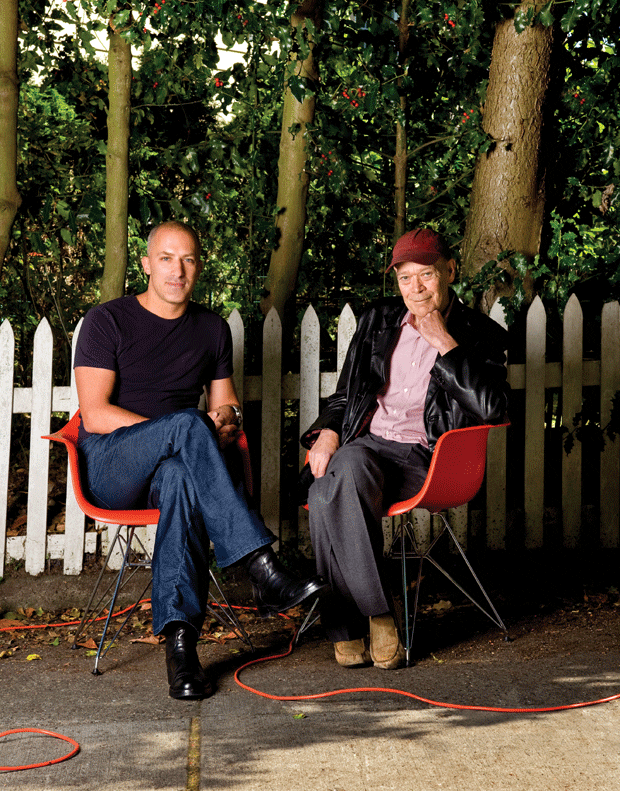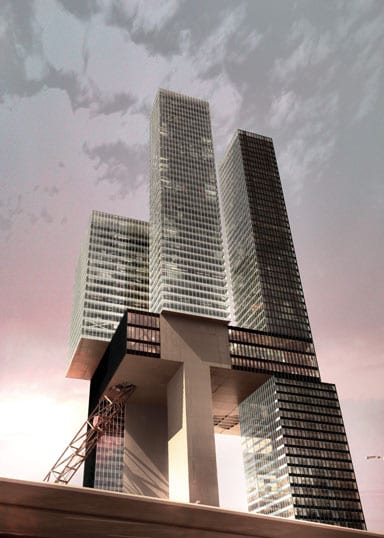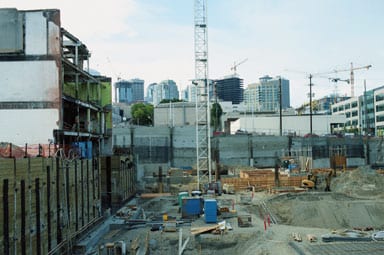
Conversation between Joshua Prince-Ramus, head of architect REX, and author Jonathan Raban. Seattle, 12 September 2008
Jonathan Raban Here’s how I thought of a beginning. I was fascinated to have this conversation with you because of that long ago book, Soft City. Its central argument, which I still stand by, was that it was against predictive, determinative, designed cities. Le Corbusier’s Cité Radieuse provided me with a prick to kick against. And I think of the book now as a defence of the ad-hoc, personal, private city that the individuals construct for themselves within the existing fabric of the urban. And it exists more in spite of city planners and architects than because of them. So it might look like we are on opposite sides of an argument, except if you consider your plans for the Forward Residence and Governors Island. Your architectural position is so radically different from, say, that of the Cubitt brothers, who created west London, and set the standard for that sort of wedding-cake stucco architecture, based on the upper-middle class English family inhabiting a five-storey house, servants above and below. West London was designed for a single class yet at the time you had the working class, living in the mews behind, cheek by jowl with the upper-middle class. But the Cubitts projected onto the city a kind of prophecy of the triumph of the Victorian upper-middle class, which of course became exploded by history: people still live in those buildings but they are all chopped up. With the Forward Residence, or Governors Island, alas, neither of which is to be built, you start off from the assumption that you cannot architect an unknown future. And you create a space that is infinitely malleable in terms of the future – the opposite of what the Cubitts were doing.
Joshua Prince-Ramus Right now the entire direction of contemporary architecture seems to be about an individual’s vision, and so two things have been lost. First, how do you remove the hand of the architect? Isn’t it actually more interesting when the architect can create a tool from which he or she then steps away allowing the user to project their own possible future on to it? Second, there is no delight in unexpected juxtapositions. I always say the most exciting thing that could happen in our [Museum Plaza] project in Louisville is a child in a bathing suit coming down from a luxury condo running into someone in a tuxedo going to an opening. But that idea seems really terrifying to everything that is being taught in architecture schools right now. We are supposed to solve problems as opposed to create opportunities for interactions that can’t be predicted, and create delight and whimsy and confusion.
JR The tuxedo and bathing suit image is just perfect because that’s what cities have essentially always been like, the collusion of unlike with unlike, rich and poor – the Babel of different languages on a city street. Completely unlike people merge in the crowd at street level and then separate out, each to go off to live in different cubicle worlds, be it a cardboard box under the arches or a white-painted mansion.
JPR I think first there should be a clear distinction between urban planning and urban design. People should be doing urban planning: creating underlying rules that set parameters that allow things to grow organically. It’s shocking but everyone seems to be doing urban design right now, which means they create a specific future perfect: it’s going to be like this on this day 25 years from now. In our office we often joke about “Google Maps design”: all these sites in Dubai whose entire design is based on what they would look like by satellite. And that is something that started with Le Corbusier. Is it good, even ethical, for a single individual to create an entire city?
JR Remember Le Corbusier’s very first words on Cité Radieuse are “The Plan: Totalitarian”. This is 1933 when the word totalitarian …
JPR … had a different meaning, particularly in French. I thought you were going to ask me about my misstep of publicly calling our work hyper-rational, and whether or not that meant I was really for totalitarian architecture. I said “misstep” because when you use the term hyper-rational, everyone usually assumes you are talking about a throwback to modernism and functionalism. But we meant doggedly holding on to core observations so that you arrive at something you simply couldn’t predict, a sort of loss of control designing the process but not knowing the end result.
JR Your diagram – your beautiful sort of stick picture – of the Seattle Public Library [which Prince-Ramus designed for OMA in 2004] and its functions demonstrated how little the existing library was actually focused on books and how much on social space. That’s what I take your “hyper-rational” to be, that kind of research rather than the hyper-rational of the prophetic design for the future, the Le Corbusier kind. Is that right?
JPR The description is right but I think we probably use the term hyper-rational meaning to cast off conventions. The whole point was that if you really are going to be rational then you have to be willing to go past certain structural limitations. If everyone says the rational conclusion is this kind of structure you have to be prepared to hold on to some absurd conclusion, because there’s got to be some conclusion that is much better than the conventional, which is seemingly rational.
JR How about para-rationalism or supra-rationalism? Hyper-rationalism sounds like rationalism only more so.
JPR The biggest concern of my partner Erez Ella, who really castigated me for using publicly a term that then everyone picked up, was that it so immediately seemed to be a re-branding of functionalism that people would think we were anti-form. But form is incredibly important to us, we just don’t talk about it in public. So we started to use the term performance instead of hyper-rationalism. The modernists made an unfortunate schism between form and function but the last 30 years have been an unfortunate pendulum swing in the opposite direction. Shouldn’t we heal the two together and simply talk about anything that performs? And if it’s predominantly form and a little organisation and programme, great, if that’s what it takes to perform. If it’s predominantly organisation, a little bit of programme and almost no form and that’s what it takes to perform, great. But stop making a distinction that seems to side with one or the other. Yet I still think that hyper-rationalism does communicate something that performance doesn’t, which is this notion of holding onto a root idea so doggedly that you become absurd and that the conclusion is therefore both perverse and absurd but also really fruitful and beyond what you would have otherwise conceived.
JR After we returned to Seattle from one of our trips to England, my daughter, Julia – she must have been six or seven – said, “I think I want to live in England.” And I said, “Why?” And she said, “When I’m at my granny’s house” – a small town of about 25,000 people plum in the middle of England – “you can walk out to the shops.” Julia fundamentally sussed the enormous difference between mixed-zone England, where the corner shop, the pub, everything is hugger-mugger with residential quarters, and zoned, boring America where residential areas and commercial areas tend to get strictly separated, except in New York and in some parts of some downtowns. It’s ridiculous that the nearest grocery store is a drive away from here. When applying hyper-rationality to a project how far are you completely stymied by things like zoning, which is the fundamental enemy of organic growth of so many parts in the United States?
JPR In almost all other intellectual pursuits there are ways in which you can set up systems that are parametric. I don’t understand why urbanism seems to be so determinate. TriBeCa, where I live in New York, was rapidly becoming gentrified before 9/11; after, probably 70 per cent of the residents left. The city created incentives for people to move back, which together with the 30 per cent of the people who had stayed have created a remarkable area in Lower Manhattan. I would say that is a kind of planning. It had nothing to do with prescribing what the buildings would look like – they just gave economic stimulus and people moved back in a haphazard way that is really nice.
JR How diverse is the new TriBeCa? Do most of the people you see now on the street closely resemble each other?
JPR I have to admit that – maybe it’s hypocritical – but I actually really like it. I don’t necessarily like the fact that everyone is upper-middle class with one or two kids. It’s different to other gentrified areas like South Lake Union in Seattle. The homogeneity is only economic – you have whites, Indians, blacks, Koreans and they are at the UN, they are artists, playwrights … Intellectually, it’s really exciting, and we have the diversity of the shops – the butcher, in the weekends the fruit stalls … But about three months ago they built a big Whole Foods right in the middle of it and everyone flocked to it in the first month. It’s deadly empty now.
JR I’m thrilled to hear it. That was the big first retail anchor for South Lake Union. Once you’ve got a Whole Foods you’re …
JPR … there. Google Maps will come to you. I don’t have any nostalgia for Seattle. It’s funny. Being from here.
JR Coming to this city as an immigrant I just had to find something to like and latch on to. And I did find places like the old South Lake Union that came nearest to reminding me of London.
JPR Trained as an architect, I don’t notice architecture very often. I can walk around New York and after six years look up and see something and go, “Whoa, I had no idea I had been walking by that every day”. The weird thing is that I am really impacted by scale so something like South Lake Union prior to gentrification wouldn’t do it for me solely because its scale is wrong, the streets too wide and the buildings too low.
JR That just sounds to me like America, you see.
JPR I’m embarrassed to say but in Manhattan I really like the financial district. There is something about the disorientation of the streets. It’s somehow more European in that respect than other areas of New York.
JR I think you are saying something close to what I always feel. The city both allows the crowd and creates separate spaces for individuals in that crowd. But take the crowd away from the city and the city virtually ceases to exist except as an empty husk. America and Britain have dealt with the crowd in fundamentally different ways. A lot of European architecture and use of the city are haunted by fear of the mob. During Mafeking Night in London – a terrific example of jingoistic media hype built on the relief by the British of a small town in South Africa during the Boer War, and greeted like man-on-the-moon high news – the whole of east London poured into west London to the terror of its inhabitants. The gentlemen’s clubs on Pall Mall barricaded themselves in while the mob flooded through and assembled in Trafalgar Square. Mafeking Night traumatised the English and I think did a good deal to shape subsequent town planning in London. It was thought that the underclass represented such a threat that they must never be allowed to control the central city. There was a consistent movement to exile the members of the mob to the outskirts so that it’d be harder for them to get together. And Paris the same way – they historically had more reasons to fear the mob. So the riots in the banlieues of Paris are a model of what happens when you try to redistribute the working class from the centre of the city. In America, something quite else happened. The immediate result of the race riots of the 1960s in Detroit, Washington DC, Chicago and LA was that property prices sagged in the areas where they had been and white flight precipitated. All the people that had been happily living in the centre of the cities were suddenly living in the suburbs outside. During the last 25 years, they have subsequently moved in to reclaim the centres. Since I wrote Soft City in 1974, every city I know has turned into a hard city because the upper-middle class has repossessed it. Rents have shot up, the people that used to provide the sort of density of city life – low-income people, immigrants, craftsmen – have been driven to the suburbs and the city has become more and more one class. South Lake Union is, to me, the perfect example of this. And it seems to me TriBeCa as well. I have a feeling I’d not like your TriBeCa as much as you do.
JPR Probably. But isn’t it about how you construct the city? I would still construct Manhattan as a soft city, even if it were totally gentrified and totally upper-middle class. I still construct my own version of it just because of its density and confusion. I still have my little path that I walk from my house up ten blocks to my office, I know where my friends live, I have my ways of reaching them by SMS, we meet in certain places. It just happens that we are in a sea of similar people but …
JR But the way in which I think of those paths is that they are uniquely private to you. Within one street there might be 100 or 1,000 private cities being mapped and each would be different from the other because of the character and the economic status of each person who is making their own route in the city. What you describe, however, is your own route in the city yet it sounds suspiciously similar to the routes that are running in parallel to it.
JPR Maybe I’m so happy to be gentrified that I’m willing to convince myself that I’m living in a very exciting, heterogeneous place. But I just don’t get this sense that everyone around me is like me.
JR I am watching Seattle now gentrify to the point where no one can afford it. It’s becoming more and more class marginalised and the streets are too empty.
JPR There was a lot of discussion about why you would ever reconstitute a bigger, better library in the middle of this city, particularly in the place where the old library was, which had become just offices and no one was there after 5.30pm. But it never seemed to me like the wrong decision. And certainly the economic analysis of the region seems to bear that out, that it’s changed its immediate surroundings. I first came here in 1982 and my perception of Seattle is that it’s always been a ghost town in the evening. To me it seems pleasantly slightly more upbeat – slightly but still totally dead.
JR What about the club scene? I mean you were here at the beginning of the 1990s and the end of the 1980s. Did you have to do with the clubs in the evenings?
JPR When we first moved here I lived in north Seattle and although we lived in single family houses in the middle of trees, it was a more sordid group of people than when we moved to Bainbridge Island and everybody was wealthy and driving really nice cars. So from my freshmen and sophomore years at high school when nightlife was sneaking out of the house at midnight and going to clubs that were full of transvestites and smoking hash and dropping ecstasy and watching my friends do heroin to my junior and senior years at high school where I was wearing buttoned-down cotton shirts and … I did it in reverse.
JR You were?
JPR Of course. I got tired of getting beaten up.
JR The city used to be the great refuge for interstitial spaces and my sense is that is increasingly less now. If you want interstices, read Dickens’ novels. They are wonderful in their sense of the possibilities of the city and the interstices inside of it. Interstices are outside the city now, in what we used to laughingly call the suburbs.
JPR We are talking about this as if there were an even flow of people. Actually, there are two huge differences. First, we’re half-way through a 100 year period when the world population is going from 2 billion to 9.1 billion. So that’s already a remarkable difference. You can’t really compare New York in 2050 to New York in 1950 because the world population will be four and half times greater. And the other is with media. I’m always amazed when I go to Phoenix or Tucson that I kind of understand these people – I don’t understand how they live, I would never live in a city of 9 million that sprawls on for 50 miles – but culturally, we’ve read the same things, our school experiences are similar. So, given that the world population is increasing so rapidly and with media becoming ever more similar, do you really think we will have interstitial spaces?
JR The only thing that I can say that’s going against the grain of what you are saying is that at the same time, especially in Britain and the United States over the last 20 years, the gap between poor and rich people has widened, and therefore so has the cultural disparity of their experiences.
JPR Except you know, I’m certainly upper-middle class in my lifestyle in New York. But if you consider my three-year-old daughter, I took her recently to my nanny’s church in Brooklyn, way out in Franklin Avenue and she was playing with a little girl who lived out there. They both know who SpongeBob Squarepants is, and they are both comparing what they got in their happy meals, which is you know the same, and …
JR Well, in 19th-century London the equivalent thing would have been news of great crimes or executions, public executions, in what is now the top of Hyde Park, Tyburn. That sense of a common media culture is not something new, I mean, the small change of talk, whether it’s in the church, or in the store or waiting for a Tube train even probably hasn’t varied much over the last hundred years – the content of it wasn’t SpongeBob Squarepants but it probably was Jack the Ripper.
JPR For some reason when you were talking about that I was thinking about how our whole conversation so far has been about Western cities, and one of the things that is interesting about Eastern cities is that they have appropriated Western types but without our stratifications. So for example, in a Chinese tower on the 32nd floor someone is raising chickens. And I started thinking maybe there is something to our projects in Oslo and Louisville that makes them kind of hyper-buildings – you can’t quite figure out if they are a building or a compact urban plan – there is some loss of control. They are mashing together all these different things and maybe that’s the West appropriating the East.
JR That’s nice. I like that idea.
JPR Let’s go back to our original question. What is the limit to which a single hand or a single entity or single enterprise should have the ability to determine something in the city? And I would say it stops at a hyper-building or a compact urban planning. That’s about as much as anyone should determine a segment of the city, something around one to one and a half million square feet. That should be the limit of urban design. Past that and we should go into urban planning. And even within one and a half million square feet, in terms of actual design, there should be more than one hand.
JR But having built these multi-purpose projects, you will find some of them dramatically changing in usage, possibly turning into slums or being re-colonised. I’m thinking the Cubitt’s single-family houses, which turn into a warren of one-pound-a-week rooms like in Notting Hill in the 1960s, or any of those warehouses in every city in the US, which everyone is trying to turn into pseudo-New York lofts. How adaptable do you think urban architecture that is happening now is going to be? What would happen during a severe economic slump in Louisville, for instance, to the physical architectural fabric of the city that is being designed now? As opposed to the architectural fabric of the city as it was designed in the late 19th century – some of us are still living in that fabric.
JPR I’m not sure those kind of conversions will happen any different from the way they do now. Often I wonder whether an 18th- or 19th-century architect would be happy about what he or she saw in a 20th-century occupation.
JR I think they’d be appalled.
JPR So maybe that’s the point. In the 22nd century, people will be occupying our 21st- century buildings in ways that would appal us. For instance, necessity has required alterations at the Seattle Library, and it’s an interesting tug on your ego. Some part of you is disappointed that the original thing, which was somehow in your mind perfect, has been changed. But its whole underlying concept was that it could be changed. Half of me is disappointed and the other revels in the fact that is getting used and getting changed – a testament to the more important idea.
JR At almost any other time in the past people thought that the modern had arrived and would stay forever and nothing would change. And that is so different from what you are doing, which recognises that the here and now are temporary, a matter of appearance and quirk and an accident, and tomorrow is likely to be incalculably different from today. Yet buildings must be made. Buildings survive their architects, their first clients, the people who move into them … I am longing for South Lake Union to become a slum.
JPR The best thing I ever heard someone say when I was at graduate school was “Great things happen in terrible buildings and terrible things happen in great buildings”. If you think as an architect that you can pre-determine experience, you are hoping for something that’s just not going to happen. The idea that a designer is creating their perfect vision which no one is supposed to touch. I’m completely shocked by that. How weirdly perverse for an architect to even want that – I can imagine wanting to retain the intellectual property of the first iteration and I would love for a client to want to come talk to me about changing it. But the idea of imposing no changes without my approval I find really bizarre. Yet that is the status quo right now.
JR I think that might be a good point at which to stop, don’t you?




















